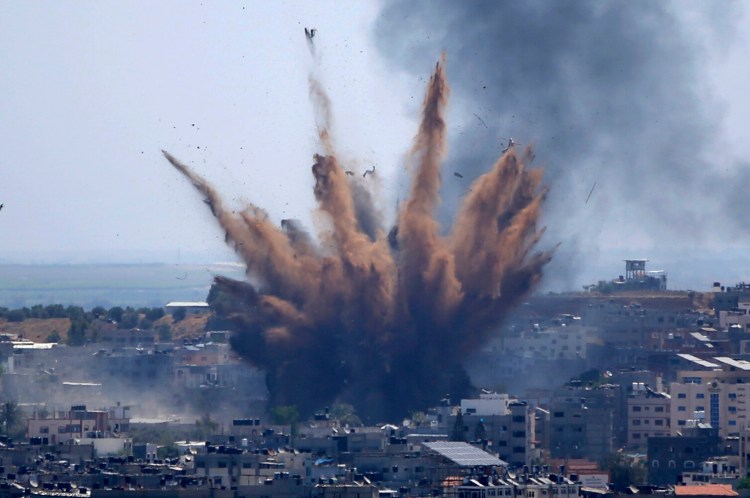According to a leading human rights group, Israel violated international law during the 11 days of fighting with Hamas militants in the densely packed Gaza Strip in May, in what “apparently amount to war crimes.”
New York-based Human Rights Watch released a report Tuesday that highlighted three Israeli strikes on Gaza in which it said 62 civilians, including families, were killed and “where there were no evident military targets in the vicinity.” It said other strikes also are likely to have violated international law.
Human Rights Watch said that Palestinian armed groups, including Hamas, which has controlled the coastal territory since 2007, also “committed unlawful attacks” in firing over 4,300 unguided rockets and mortars into Israeli communities. The organization said it would release a separate report on Palestinian violations in August.
The report renews scrutiny on this May’s deadly exchange of Israeli missiles and Hamas rockets in which over 250 Palestinians in Gaza, among them 67 children, and 13 residents of Israel, including two children, died. It was the fourth war between the two sides since 2009, alongside frequent flare-ups.
Israel has argued that it took precautions to protect Palestinians civilians and only struck targets related to Hamas, which it accused of intentionally operating in residential areas thereby leaving Israel little recourse.
But the report’s findings could be used as part of an ongoing investigation by the International Criminal Court of violations by both Israeli forces and Palestinian armed groups. The court in February ruled that it has jurisdiction over the Palestinian territories that Israel occupied in 1967, a claim Israel rejects.
Palestinians have increasingly lobbied for rights in international bodies and agencies as the model for peace talks between the two sides has broken down.
Hamas said 80 of the dead in Gaza were militants, according to the Associated Press, a figure Israel has disputed and claims is higher. One of the dead in Israel was a soldier.
While most rockets fired from Gaza were intercepted by Israel’s Iron Dome defense system, the nearly two million Palestinians in Gaza had few places to flee. Israel controls nearly all points of entry into and out of Gaza, which is facing multiple compounding humanitarian crises, including a severe lack of clean water, electricity, and economic opportunities. Most Gazans cannot leave and Hamas, an extremist group, suppresses any internal opposition.
Human Rights Watch said that Israel refused to permit its senior investigators to enter Gaza. For the report, it relied on a local Gaza researcher, as well as satellite images, expert analysis of photos and munition fragments, and phone and video interviews.
In one of the attacks investigated, Human Rights Watch said that around 6 p.m. on May 10 an Israeli-guided missile hit four houses belonging to the al-Masri family in an area near the town of Beit Hanoun. Eight civilians, including six children, were killed and 18 reported injured. No members of the family were part of an armed group, they said, and Israeli did not list any of the dead as members of a militant group.
The Israeli military has said that the strike was caused by an errant missile fired from inside Gaza by the militant group Islamic Jihad aiming for Israel.
On social media, it also suggested that one of those identified as a victim in the strike was part of a group of “activists” with Hamas and Islamic Jihad, which the family has denied, Human Rights Watch found.
Speaking with residents and analyzing footage, Human Rights Watch’s found that the blast site was consistent with damaged caused by missiles that Israel is known to use and inconsistent with Islamic Jihad rockets. The absence of an impact crater, among other signs, suggested that it was the result of “munition with a small explosive yield” that detonated in midair,” the report said.
The group said it “found no evidence of a military target at or near the site of the strike.”
On May 15, 10 civilians, including eight children, were killed when a U.S.-made guided bomb collapsed a three-story building in the Shati refugee camp around 1:40 a.m. Israel said it was targeting an apartment used by Hamas militants. It said the missile struck a bunker below, which led the building to fall.
Residents told Human Rights Watch they did not know of any Hamas cell or operations in their building. The group also did not find evidence of a bunker below.
The group called for further investigation into “whether Israeli forces targeted a military objective, and, if there was a legitimate military objective, whether all feasible precautions were taken to minimize civilian harm.”
In another deadly series of Israeli airstrikes on May 16, 44 civilians were killed during a four-minute long assault on al-Wahda Street in Gaza City in which three multistory buildings collapsed. Among the dead were over a dozen members of an extended family and one of the doctors leading Gaza’s covid-19 response.
The Israeli military said it targeted a series of underground military tunnels and a command center, though it has not publicly provided evidence. Human Rights Watch found no evidence of military targets in the area and that residents had not been warned to evacuate in time.
“An attack that is not directed at a specific military objective is unlawful,” the group said.
Human Rights Watch has previously accused both Israeli forces and Palestinian armed forces of abuses, including apparent war crimes. In April, it released a report charging Israel with “the crimes of apartheid and persecution” against Palestinians in the military-occupied territories and inside Israel.
Over the years, said Omar Shakir, the Israel and Palestinian territories director at Human Rights Watch, “we have documented a pattern of excessive force, attacks that are disproportionate, indiscriminate … that did not hit an apparent military target.”
“Accountability is critical,” he added.
Comments are not available on this story.
Send questions/comments to the editors.


